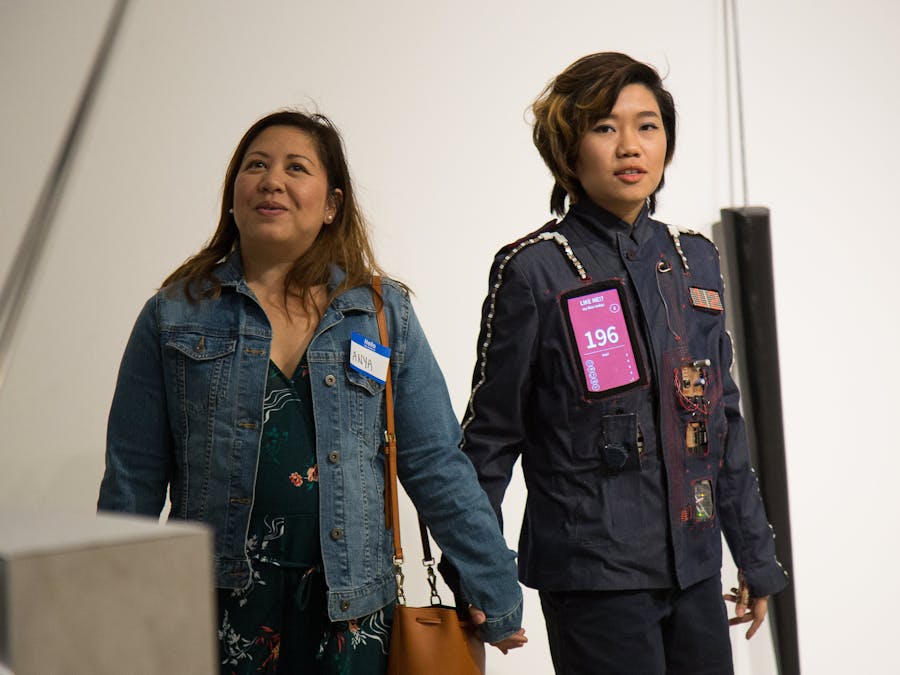Before you started reading, you may want to check out the two video documentation to understand the artwork.
The wearable's functions:
People interaction:
For more info and photos: https://tuangstudio.com/portfolio/social-media-without-the-internet
----------------------------------
It is all started from the curiosity of what makes humans perceive information online the way we do nowadays. Whether the small information to big data online, such as an online dating profile, emoji code interpretation, and the complicated info graphic for enterprise, humans have ways of interpretation and understand these things based on various factors like, cultural backgrounds, native languages, and education. Thus, the research called, "Digital Sense, " is begun to examine how humans in the modern days have developed a new senes --the "digital sense"-- to interact with all these digital contents. The process of research included an art practice to produce an art innovation. In this research, there are two innovations namely, Social Media without the Internet, which examine the sense of touch, and Signal Moods, which explore the sense of hearing. Social Media without the Internet has been out to the public at UCLA, New Wright Gallery, and Little Tokyo in Los Angeles.
“Social Media without the Internet” is an interactive performance art project, created as an examination of how the human sense of touch is applied with the new digital sense of human in the society. Social Media without the Internet consists of two mediums: art object and performance. The art object is a tech wearable. Its functions are designed to be operated by hand gestures when people are socializing, i.e. handshaking, high-fiving, shoulder-tapping, and handholding. The performance is a medium of investigation of the way social media’s interactions can be introduced into the real world. The project encourages people to socialize and invites them to have more intimate interactions with one another.
These two mediums, the wearable and the live performance, were created to invigorate and inform each other. The interactive part of the wearable functions as a collector to amass data from interactions with participants, while the performance works to make that interaction happen. The wearable is designed as a blazer, an informal suit jacket without matching pants, that looks casual enough to be worn with other street-style clothing. In the gallery setting, there is live video of the jacket wearer and participants interacting streaming on monitors, which represents the broadcast of interaction between users on social media. However, without the Internet, the live stream operates as a “local area network” only.
There are also two principal topics that were parts of the development of Social Media without the Internet that merit in-depth discussion. The first is the result of digital interaction on social media platforms. These results are front-end data that present as numbers to users. Society has known these numbers since the arrival of social media, which ultimately they have affected everyday human life in many aspects. I call them “social media data." The blazer allows 6 methods of interactions: add a friend, unfriend, give a like, dislike, follow the wearer, and following someone. With these interaction methods, the wearable can collect 4 types of data: likes, followings, followers, and friends.
- Add friends => Shake hand
- Unfriend => Press switch on the left chest
- Add Likes => High-five or click on emoticon icons on the front monitor
- Dislikes => Click on ” X ” on the front monitor
- Follow => Press on the right shoulder pad (to follow the person)
- Following => Pull the string below the front monitor (to lead the person)
The second principal topic is humans’ common physical interaction among each other. Humans have different ways of interaction using body language based on individual personalities and cultures. However, because of some similarity of expressions, when we cannot communicate in a certain language functionally, this bodily language will be used as a primary communication method. For example, when traveling to a foreign country without fluency in its verbal language, we may notice that we use our hands more to describe something. Body language also involves a sense of touch, so this wearable is purposefully operated with four simple hand gestures: handshaking, hi-fiving, shoulder-tapping, and handholding. However, the actual interactions with viewers/participants are limitless.
"Social Media without the Internet" is a successful prototype of what we could use to learn and explore about digital humanity. The project is still in development and will have advanced prototype coming out in the future.





















Comments